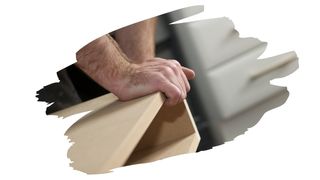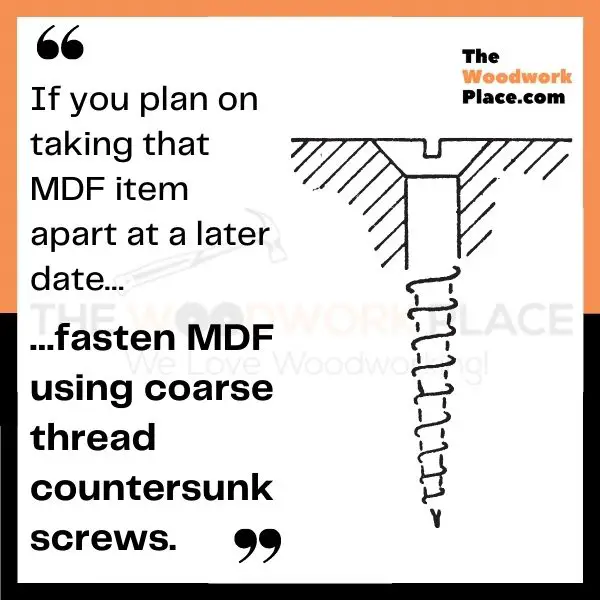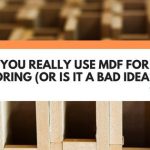MDF isn’t the easiest material to fasten, especially if you’re using nails or screws. Still, a simple way to get MDF to stick, is by using good old wood glue.
Now, gluing MDF isn’t the problem here. The real challenge, however, is keeping glued MDF in position while we wait for the adhesive to dry.
So, the best approach to fastening MDF is to use a heavy-duty multipurpose wood glue. And then, use nails to hold and support MDF in position (while the glue dries).
Once the glue has dried, it will be strong enough (regardless of those nails), to hold MDF in it’s place.
Related Post: 4 Key MDF Wood Disadvantages (+ 3 Main Advantages)
But is permanent wood adhesive really the only way to fasten MDF? What if you want to take apart that MDF furniture item later on?
Well, in this post we reveal the best type of screws you can use on MDF (allowing you the option to easily transport MDF furniture). You will also learn why a solvent-free glue isn’t the best way to permanently fasten MDF.
And we reveal how you can get screws to ‘bite’ into a smooth MDF surface, each and every time…

This post may contain affiliate links to products that we receive a commission for (at no additional cost to you). Learn more here.
What Type Of Fasteners Should You Use To Attach MDF?
The easiest way to fasten MDF is to combine wood glue with nails.
The glue is the key binder here, bonding MDF more tightly than any other fastener. The nails, on the other hand, are simply there to provide support. The nails will keep that MDF in place until the glue has finished drying.
Any multi-purpose solvent-based glue will work on MDF.
One thing to keep in mind – wood glues create a barrier that makes it really difficult for wood stains and other penetrating finishes to soak into the wood.
So if your project includes staining or finishing bare MDF, you’ll might want to test things out first before committing to wood glue. That water-tight glue seal can block the absorbency needed for an even stain application.
Check out our post here for tips on using wood glues alongside wood stain: Can You Really Stain Over Wood Glue? (What You Need To Know)
Related Post: What’s The Best Nailer For MDF Trim? (Everything You Need To Know)
Can You Use No More Nails Glue On MDF?
No More Nails is a heavy duty glue that can be used to glue almost anything to any surface. It is a superb product for adhesion, and it binds even more strongly than other types of wood glues.
But, this solvent-free glue is water-based, and that can create adhesion problems when using it on MDF.
You see, MDF is very water absorbent. Given half a chance, MDF will happily soak up moisture like a sponge.
Related Post: Why Is My MDF Board Warping? (+ How You Can Fix It)
In fact, MDF is so water absorbent that (as a general rule of thumb) it is only best suited for interior structures and furniture. You can learn more by checking out our post here: Can You Really Use MDF Outside? (Best Practice Revealed!)
So, MDF is going to end up absorbing all of the moisture from a water-based glue (well before that adhesive has even had the proper time to set).
In short; MDF won’t stick and stay if you glue it using a water-based glue.
However, if you were to use a solvent-based glue, you wouldn’t have to worry about any MDF moisture-wicking problems. And you can find a quality solvent-based glue in Evo-Stik’s Gripfill.
Evo-Stik is a solvent-based multipurpose glue that can bind anything. Not only can it handle MDF, it can also glue stone, drywall, and even brick.
But make sure you get the green tubed solvent-based version of this glue. That is because they also offer a solvent-free version of Evo-Stik Gripfill (in a yellow tube). However, that version won’t work on MDF for the same reasons as any other solvent-free glue.
And How Do You Nail MDF Down?
If you want to nail MDF firmly in place, then the length and thickness of those nails are key.
A longer nail – one that is also much thicker – will hold even heavy MDF in place.
However, if you simply want to keep MDF propped up while glue sets, then a thinner and shorter brad nail will do in a pinch.
Brad nails can range from 0.5 inches to 2.5 inches long, and they are thinner than a finishing nail.
But, because they are so slender, they are less likely to split MDF. Especially if you avoid nailing too close to the edge.
However, when it comes to attaching wood together, Brad nails just don’t really have great holding power over time.
In fact, we have a whole post that goes more in-depth about when brad nails are the best option for fastening wood… and when you’re better off using something else.
Check out our post ‘Are Brad Nails Or Finish Nails Better For Setting Up Your Bookshelf?‘ if you want to learn all about the ideal uses for brad nails versus finishing nails.
Related Post: Can You Use Polyfilla On MDF? (What You Need To Know)
Will Screws Really Take Hold In MDF?
Honestly, out of the three main fastening methods, screws are probably the trickiest way to fasten MDF.
And this is mostly because of the way MDF acts around screws. MDF can tend to blow out and churn up around most standard screws.
Plus, nailing MDF into place doesn’t fair much better either, in terms of holding power. You can find out more about the differences in the holding power of nails and wood screws by popping on over to our post here: Should You Use Nails Or Screws On A Wooden Fence? (Solved!)
How Do You Screw MDF Without It Blowing Out?
You can counteract blow-out by using countersunk screws, (also referred to as ‘flat-head’ screws). These screws will sink down flush against the surface.

Also, while most standard countersunk screws can work with MDF, it is still hard to get them to ‘grip’ and turn into that smooth surface. Which is why you also need to make sure you are using screws that come with a coarse thread.
A coarse thread screw has a wider distance between threads than a fine thread screw.

When you compare these deep thread screws against fine thread screws, pound for pound, fine thread screws are stronger than coarse thread screws in general.
However, the increased space between the threads of those coarse thread screws helps to reduce tearing.
In other words, there is less ‘churning’ of those wood chip fibers as you turn the screws. And that, in turn, reduces the chance of those screws splitting apart those tightly packed MDF fibers.
And Does MDF Need Pilot Holes?
If you are using standard coarse thread screws, then yes, they do need a predrilled pilot hole. Pilot holes are small predrilled holes designed to help guide screws into place.
Side Note: If you are using specialized MDF screws, you won’t need to predrill pilot holes, but more on that a bit later.
You will need to predrill a deep hole, one that is slightly bigger than usual, if you want those screws to really catch and bite into MDF.
Use our screws pilot hole guide below. In it we list the optimal pilot hole sizes for every screw size.
You can get an instant copy of our screws pilot hole guide by clicking here.
Simply follow the ‘Counter Sink Size’ section of our chart when it comes to sizing up your MDF pilot holes.

Do You Need Any Kind Of Special Screws For MDF?
You don’t, but it’s easier if you do use a specially designed MDF screw. Especially if you can get your hands on ones that don’t require any predrilling (saving you a lot of time and effort).
So, What Are The Best Screws For MDF?
The best screws for MDF, by far, are SPAX MDF Countersunk Screws.
These screws have a clever drill-like thread at the tip, allowing these screws to cut into MDF without needing a pilot hole. Plus their countersunk head sinks in flush and securely.

To Wrap Up, Here Are Your 3 Key Takeaways…
- 1). The best way to permanently fasten MDF is to use a solvent-based glue.
- 2). Only use nails, (ideally brad nails), as a way to support MDF while the glue dries.
- 3). Otherwise, (if you plan on taking that MDF item apart at a later date), then fasten MDF using coarse thread countersunk screws instead.
References:
Effect of Panel Moisture Content and Density on Moisture Movement in MDF



